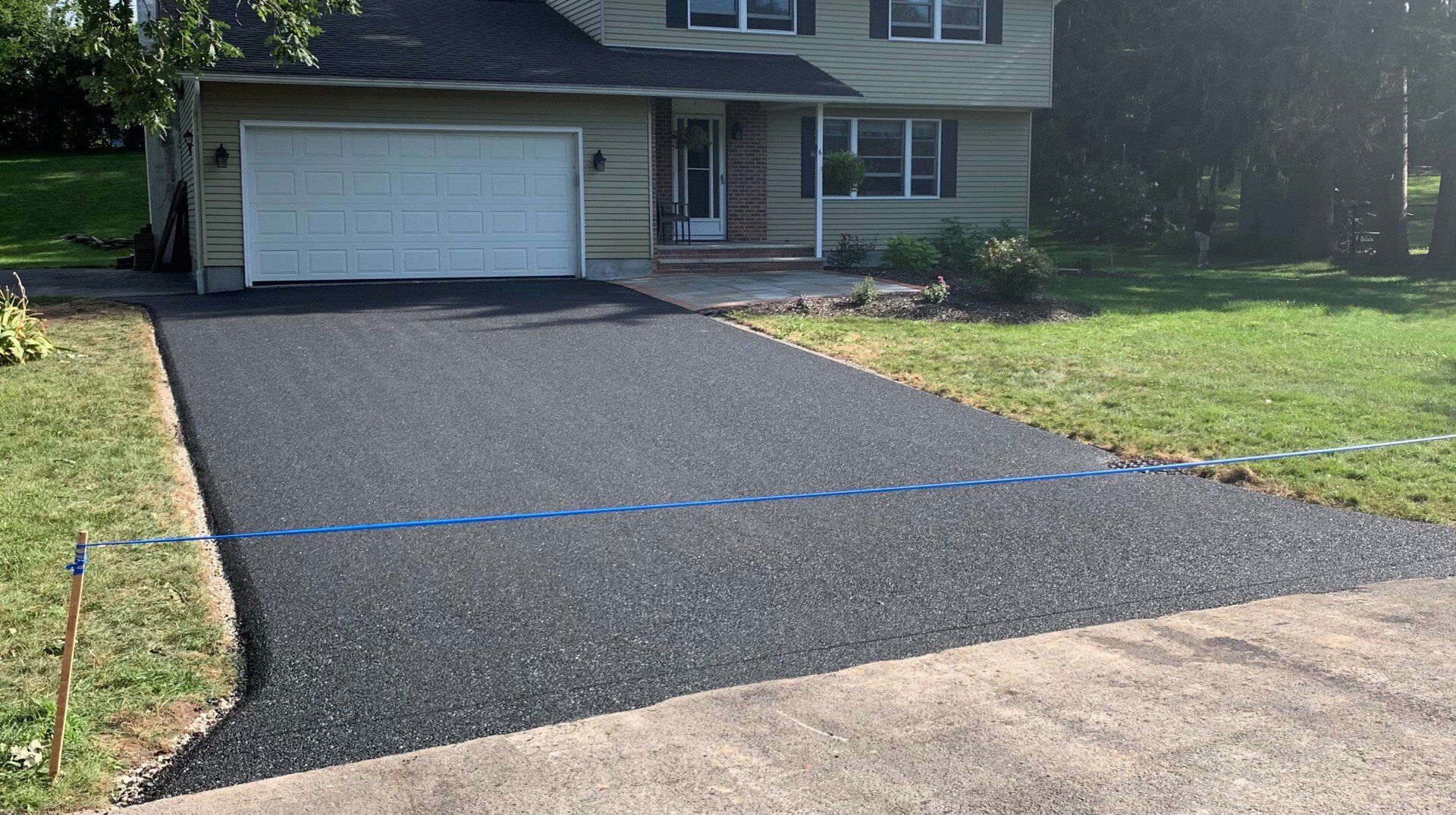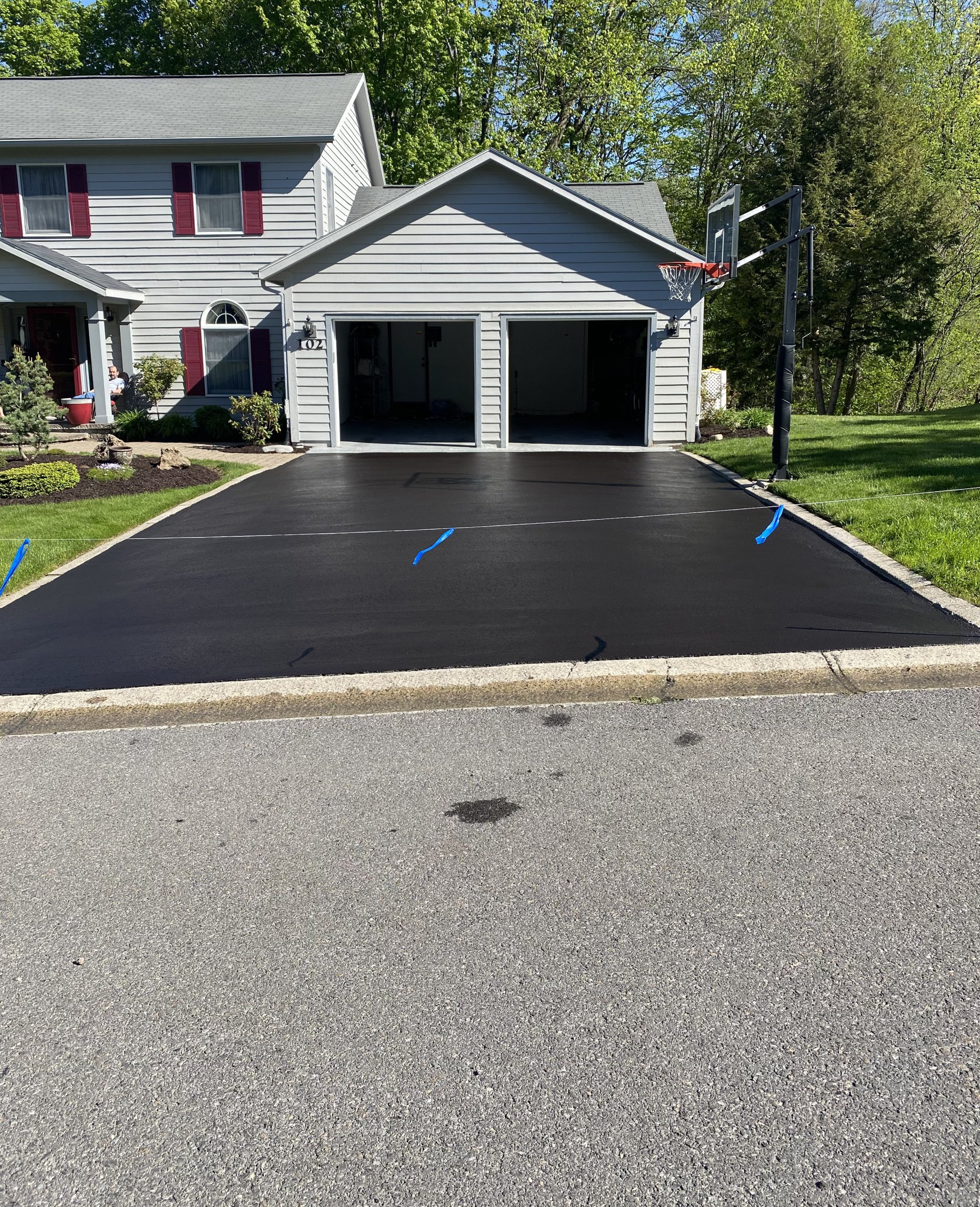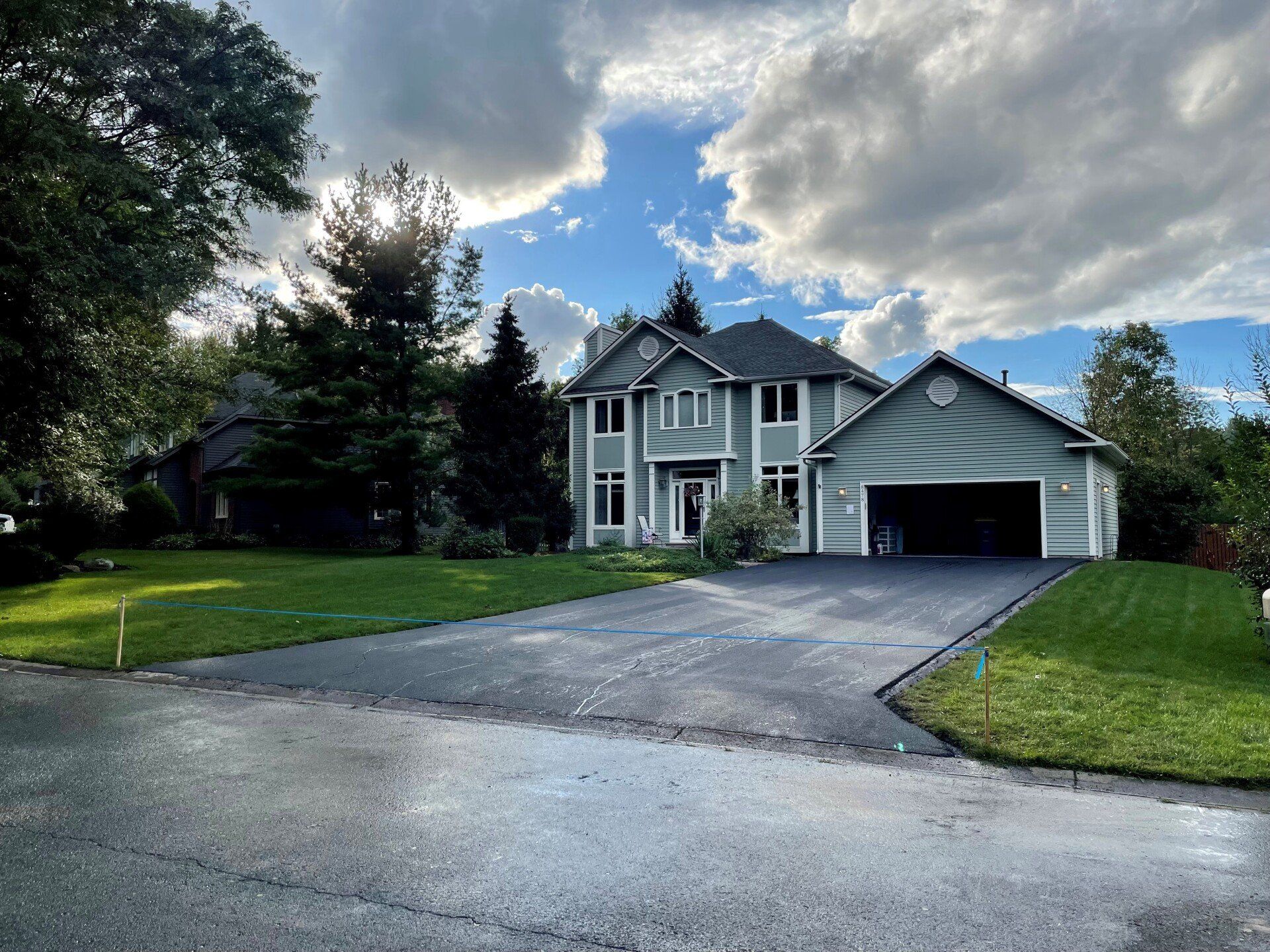
Remove and Replace
A remove and replace (R&R) is a complete rebuild of the existing driveway or asphalt area. To understand what constitutes an R&R, we must first learn the different layers (materials) that make up an asphalt surface in the first place:
- Sub-grade: the sub-grade, for lack of a better term, is earth. It is the native soil that is found under the ground in the location of the asphalt project (think clay, sand, loam, silt).
- Sub-base: the sub-base is the layer of compacted material that is installed on top of the sub-grade. It creates the foundation for the eventual installation of asphalt (think runner-crush stone).
- Asphalt Concrete Layers: also known as blacktop, pavement, macadam, and asphalt, the asphalt concrete is the drivable surface of a driveway, parking lot, and roadway. It’s the black surface that comes to mind when you think of a driveway and it is installed in two layers: a binder course and top course.
When undergoing an R&R the driveway is completely ripped out to the sub-grade, meaning that the blacktop layers and the sub-base (existing runner-crush stone base) are being removed until just the sub-grade is exposed. The sub-grade is then covered with geo-textile fabric and the sub-base is rebuilt with new runner-crush stone. When the new runner-crush stone has been compacted, the asphalt layers will be re-paved, starting with the binder course and finishing with the top course.
What Is Geo-Textile Fabric And Why Is It Important?
Geo-textile fabric is a material composed of woven-nylon strands that is a little thicker than paper. It acts as a membrane between the sub-grade & the runner-crush sub-base and prevents the two materials from mixing. It is a critical tool in keeping asphalt surfaces from rutting (i.e. showing tire tracks/depressions).
Think About It
What would happen if you were to put stones on top of dirt and then drive over the stones with your car? Well the stones would get pushed into the dirt, of course! If you continued this pattern over time and kept driving over the stones, the stones would get pushed deeper and deeper into the dirt until ruts formed. Now, if asphalt layers were present on top of the stones, the asphalt would gradually form into ruts as well. This is a big no-no.
This can all be prevented with the installation of geo-textile fabric. Let’s take the same scenario of driving over the stones with your car - but this time there is going to be a layer of geo-textile fabric separating the stones from the dirt. No matter how many times you drive over the stones they will not be physically able to get pushed into the dirt, as the fabric layer is preventing this from happening. Therefore, driveways that have geo-textile fabric installed underneath the runner-crush stone sub-base will not form ruts and will have much greater longevity than driveways installed without it.
Different Layers Of Asphalt Concrete
We’ve mentioned that there are two different layers of asphalt concrete that make up driveways and parking lots: the binder course and the top course. Before we discuss the differences in the two different layers, let’s briefly explain what asphalt concrete even is.
- In layman’s terms, asphalt concrete is a bunch of rocks and sand that are “glued” together with a combination of petroleum and intense heat.
- The “rocks,” in this case, are the most readily available minerals found in quarries for a given geographical location and are referred to as “aggregates.” In New York, for instance, the mineral most commonly used is limestone and it can range in size from chunks the size of your fist down to pieces as fine as sand.
- Asphalt manufacturers take these different sized aggregates, along with a liquid asphalt binding agent, and use them to produce asphalt concrete.
- Now that we have a rough idea of what asphalt is, let’s touch on the differences between the binder course and the top course:
- Binder Course: this is the first layer of asphalt that goes into an asphalt installation and it is installed directly on top of the prepared runner-crush stone base. It is the “weight-bearing” course of asphalt and therefore utilizes bigger aggregate pieces in the size range of quarters, nickels, and dimes. Not only does the binder course contain bigger aggregate sizes, but it is also thicker (in terms of the depth at which it is installed) compared to the top course.
- Top Course: this is the final layer of asphalt that goes into an asphalt installation and it is installed on top of the binder course. Often referred to as the “wearing course,” “surface course,” or just “topping,” the top course utilizes aggregates that are just a fraction of the size of what is used in the binder course. Because topping has many more fines (smaller aggregate) in the mix design, its surface appearance is much tighter & smoother, more appealing to the eye, and is better at shedding water than the more porous binder course.
A quick note on virgin asphalt vs. recycled asphalt:
As mentioned above, asphalt is a bunch of rocks and sand glued together with a combination of petroleum and intense heat. This is known as “virgin asphalt,” and it is the best kind of asphalt to install on a job.
Recycled asphalt, on the other hand, is an inferior asphalt mixture but is commonly found in the paving industry due to its low cost. In short, recycled asphalt is virgin asphalt that has been infused with roadway millings. When you are driving around in spring, summer, and fall and you see the signs that say “grooved pavement ahead,” the process that is taking place is called milling (also known as cold-planing).
What’s happening here is that the old, beat up surface of the roadway is being ground down a couple of inches so that a new asphalt surface can be installed without raising the elevation of the roadway itself. The ground bits and pieces (millings) of the old roadway are then commonly trucked back to the asphalt plant and dumped into a huge stockpile. Asphalt plants that produce hot-mix asphalt for the State of New York are required by the state to infuse these millings back into virgin asphalt mix, thus recycling the old roadway surface. The stated goal by the State of New York is to get 50% of the asphalt mix to contain millings, with the current percentage close to 40% at the time of writing.
In theory, this sounds good. After all, who doesn’t like to recycle, right? The trade-off here, however, is that recycled asphalt lacks the integrity and longevity that its counterpart – virgin asphalt – has. Our objective at Dependable Paving is to build you an asphalt surface that will last as long as possible, and part of that process includes buying the best materials that we can. The best material in the asphalt industry is virgin asphalt, and although it comes at a premium, it’s the only asphalt we believe in using.
Putting It All Together
Now that we understand the different layers that make up driveways and parking lots, what does the process look like to turn an old, damaged, beat up driveway into a new, beautiful, pristine driveway that will last decades? Let’s take a look at each individual step below:
1.) Excavation (Phase I)
First things first: the old driveway needs to be completely removed down to the sub-grade. If your driveway is need of an R&R, it means that there is sub-base failure that needs to be corrected. The only way to correct sub-base failure is to rip out the old, failed sub-base and construct a new one from scratch.
A big mistake that is often made by paving contractors is to install new asphalt over asphalt that has failed due to sub-base failure. This is often done as a cost-saving measure since sub-base reconstruction is a more cost-intensive procedure. The truth, however, is that the new asphalt that is installed over the already-failed asphalt will (you guessed it!) fail as well! Think about it - when a patient in a hospital needs surgery, the surgeon is not going to just put a bandaid on the afflicted area and call it fixed. Rather, the surgeon is going to go in and fix the problem at its root so that it is no longer a problem. The same principle applies to driveways with sub-base failure.
Driveway excavation, by Dependable Paving’s standards, means ripping out the driveway 12 inches below final grade. Final grade is the elevation that the driveway is going to be at when all the layers of the driveway are installed. Think of final grade as the elevation of structures that you expect the driveway to be flush with when the driveway is completely installed (garage floors, walkways, roadways, curbs, etc). Once the final grade has been determined, the old driveway will be excavated 1-foot below that elevation.
A couple notes on Dependable Paving’s depth of excavation:
- The chances that the sub-base of your existing driveway goes down 12 inches is slim to none, but we are not recreating your existing driveway specs.
- We need room to rebuild your driveway with the proper depth of materials so that it gets our “heavy-built” stamp of approval.
- The specs listed below for depth of stone and asphalt layers are pre-compaction numbers. When compaction is accounted for, all the layers fit nicely into our 12 inch excavated pit.
2.) Installation Of Geo-Textile Fabric (Phase I)
Now that the old driveway has been removed, it’s time to start reconstructing a proper runner-crush stone sub-base. And yes, there are improper sub-bases and your old driveway probably had one, hence the need for an R&R.
After excavation, the sub-grade is completely exposed and is not yet suitable for the installation of any stone. Though it was mentioned above, it’s important to drill this point home again: it is not proper practice to put stones on top of dirt without a membrane separating the two materials! The membrane that we use is a woven nylon geo-textile fabric due to its ability to let water drain through into the sub-grade while not allowing the runner-crush stone to get pushed into the sub-grade under the weight of your vehicles.
You will sometimes hear that geo-textile fabric is installed to prevent weed growth. This is not the case. Engineers designed it to prevent tire ruts on heavily trafficked roadways and it is used in all roadway construction as per DOT specifications. Think about it - when is the last time you saw tire ruts on a highway? Probably never (potholes on the other hand? We’ll save that rant for another time).
The main point to take away here is that the installation of geo-textile fabric is a critical, but also commonly overlooked, first step in sub-base construction for driveways. Don’t sell your driveway short and make sure that whichever contractor you hire is installing geo-textile fabric over the sub-grade. It’s an inexpensive step that truly increases a driveway’s longevity.
3.) Installation Of Runner-Crush Sub-Base (Phase I)
Now that the old driveway’s been removed and the sub-grade is now covered with geo-textile fabric, the next step is to rebuild the sub-base with 10 inches of runner-crush stone.
Runner-crush stone is limestone (or whichever mineral is most commonly found in quarries nearest you) that has been mined from the earth and broken up into different sizes by a machine called a “crusher.” After being crushed, the bits and pieces of limestone are jagged, angular, and dusty (stone dust), which are imperative characteristics for the stones to be able to “lock together” and create a structurally sound sub-base. Just like with asphalt, there are various sizes (grades) of runner-crush stone to suit different needs on the job site. We will be focusing in on two grades: 4” Minus stone and 1” Minus stone.
- 4” minus: (also referred to as minus-4 stone) after being crushed, the bits and pieces of limestone get segregated through a series of screens. The screens that create minus-4 stone have slots that are 4-inches big, meaning that pieces of the crushed rock that are 4-inches and smaller will be able to fall through the screen. Hence the designation “minus-4.” Due to this screen size, big and chunky pieces of rock (think the size of your fist) fall through and will eventually end up underneath your driveway.
- 1” minus: (also referred to as regular runner-crush) just like with minus-4 stone, 1” minus stone is crushed through the same process yet it is filtered through a smaller screen. The slots in this screen allow for stones that are 1-inch and smaller to fall through.
Dependable Paving’s sub-bases consist of 10 inches of stone, installed in two separate lifts. A “lift” is when a layer of material is installed at a certain thickness and then compacted into place by vibratory compaction equipment.
The first lift consists of 8 inches of minus-4 runner-crush followed by a final 2-inch lift of regular runner-crush. Dependable Paving uses minus-4 stone as the base lift in our sub-bases due to the sheer size of the stones involved. Remember, “the bigger the stone, the harder it is to bully out of the way.” Minus-4 stone can support tremendous weight and allow ground water to run through it without it shifting - two very important attributes.
However, since the size of the aggregate in minus-4 stone is so large, its downfall is that it is very hard to get a smooth final grade with it. This is where regular runner-crush comes into play. Because the stones in regular runner-crush are smaller and have a slightly higher percentage of stone dust, it is much easier to achieve a smooth final grade with it. Final grading in sub-base construction is one of the most important steps because it’s the last chance to get the grade right (in terms of water flow) for the next step in the process: installing the binder layer of asphalt.
4.) Installation Of Binder (Phase I)
Finally, the table has been set and dinner is ready to be served! Dinner, however, consists of 300°F rocks covered in a petroleum sauce. Delicious! In reality, though, every prior step up to this point has been “setting the table” for the installation of the asphalt. The old driveway has been removed, the sub-grade has been covered with geo-textile fabric, and both lifts of runner-crush stone (the sub-base) have been properly graded and compacted in place. We are ready for the main course: binder.
As mentioned above, the binder layer of asphalt is the first layer of asphalt that goes into a driveway or parking lot installation. Similar to how the minus-4 lift of runner-crush is the weight-bearing lift of stone due to the larger aggregate size, the binder layer of asphalt is going to be the weight-bearing lift of asphalt due to the larger aggregate size in the mix. We install a 3-inch lift of binder through a self-propelled paving machine and then compact it with a double-drum vibratory roller to achieve a smooth and uniform surface.
Once the binder layer has been installed and compacted, Phase I of the new driveway is now complete. The homeowner will need to wait about 24 hours for the asphalt to cure and cool down before being able to walk on it and roughly 3-5 days before being able to drive on it with their vehicles. Though the homeowner now has what is considered a brand new driveway, it’s not fully completed yet. As mentioned above, there are two layers of asphalt that go into a driveway or parking lot: the binder course and the top course. Phase I of a new driveway covers everything from ripping out the old driveway up to installing the binder layer of asphalt on the new driveway. Phase II, which we will discuss next, involves installing the top course over the binder the following season.
5.) Installation Of Top Course (Phase II)
The first thing you might ask about the top coat is “why does it get installed the year after the binder layer is installed? After all, roadways don’t need to wait a year until they receive their top coat and my neighbors down the street had theirs installed the same year as the binder! What gives?”
This is a very common and reasonable question that many property owners ask and the answer comes down to freeze/thaw cycles. In the NY climate, we get large amounts of precipitation: on average we receive 41 inches of rain and 104 inches of snow per year. All of this water has to go somewhere, and a lot of it ends up in the ground. With a heavily saturated sub-grade, the ground is subject to massive heaving and hawing (expanding and contracting) as the ground freezes and thaws during the winter and spring months.
The idea behind waiting a season to install the top coat is that we want to give the new sub-base and binder layer a chance to “settle in to place.” We want it to be able to move up and down with the earth as the ground freezes and thaws without the final layer of asphalt installed. Think about it: if the final layer of asphalt was installed and then the driveway settles over its first winter, there is nothing that can really be done about that settled area to bring it back up to surface grade. You could, of course, have it patched, but now you have a brand new driveway with a patch in it. The ideal solution is to give it a chance to settle over the first winter and then “shim” any settled areas (IF they arise!) before the top coat is installed. “Shimming” is simply adding hot mix asphalt to a low area to raise it up before installing a new layer of asphalt over the top of it. Now we have a driveway that has gotten most (if any) of its settling out of the way and we can confidently install the top coat without worry of it settling over the winter.
Another beautiful aspect of this method is that it allows the homeowner to pay for the driveway over the course of two years. Phase I costs are incurred in the first year while Phase II costs are incurred in the second year. Dependable Paving will never ask for Phase II payment in the first year of the driveway’s construction and will only accept payment upon completion of each phase of the work with nothing in advance.
The Bottom Line
While asphalt driveways and parking lots may all seem the same from an outside perspective, they are not all created equally and they will not age the same. There are plenty of different variables to take into consideration including, but not limited to, the depth of the build, the types of materials used, the thicknesses of materials, etc.
If you have read through this guide then you are most likely in possession of a driveway that is in rough shape and needs to be completely removed and replaced from the sub-base up. You now have a better understanding of what it takes to build a proper asphalt installation that will last you decades. It’s a little bit more nuanced than just slapping in some stone and making the surface black, but it’s also not rocket science. Like anything else in construction, it’s important to build on a strong foundation. Dependable Paving believes that a strong driveway foundation consists of 10 inches of stone installed on top of geo-textile fabric, covered in the best asphalt that money can buy -virgin asphalt- to ensure ultimate longevity of your pavement surface. As the old saying goes: the bitterness of poor quality remains long after the sweetness of low price is forgotten.





